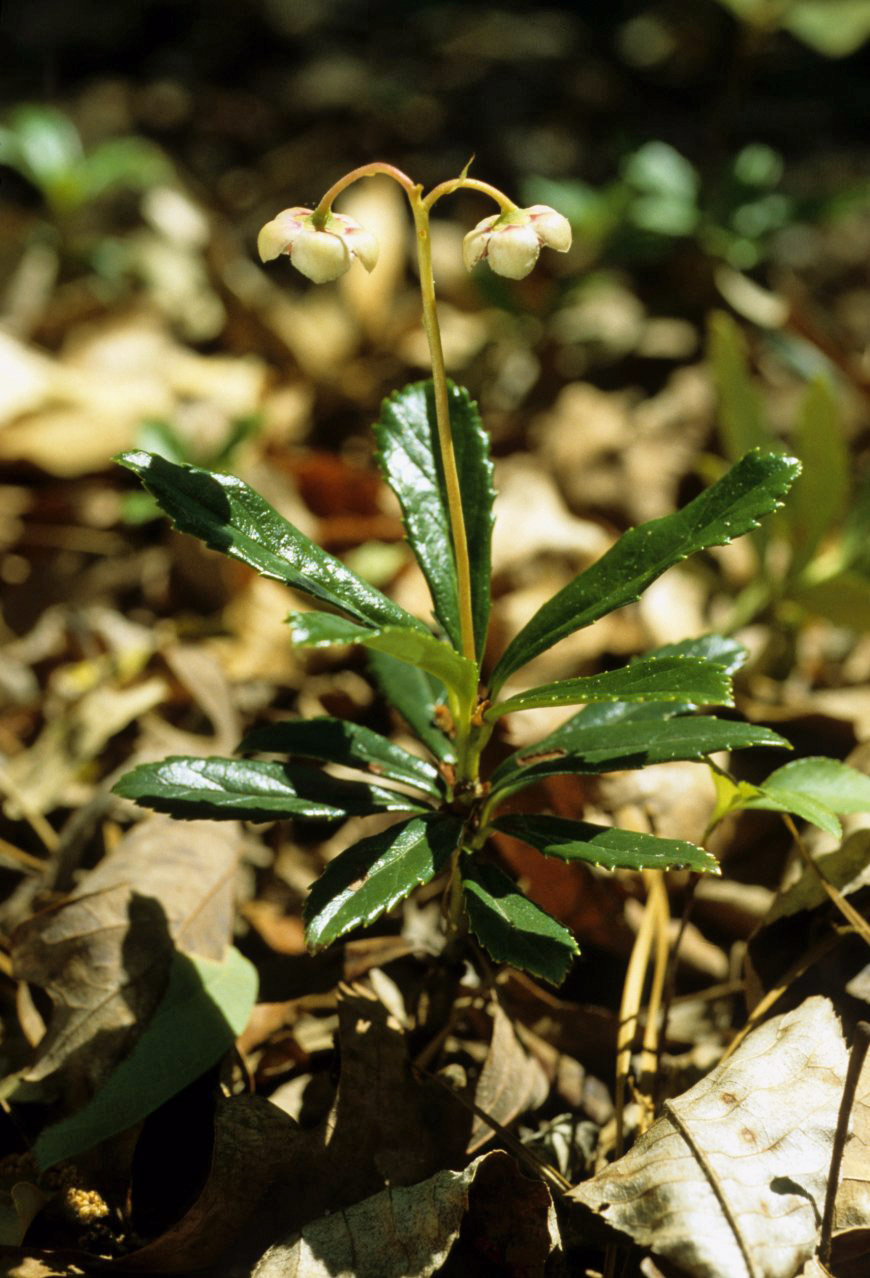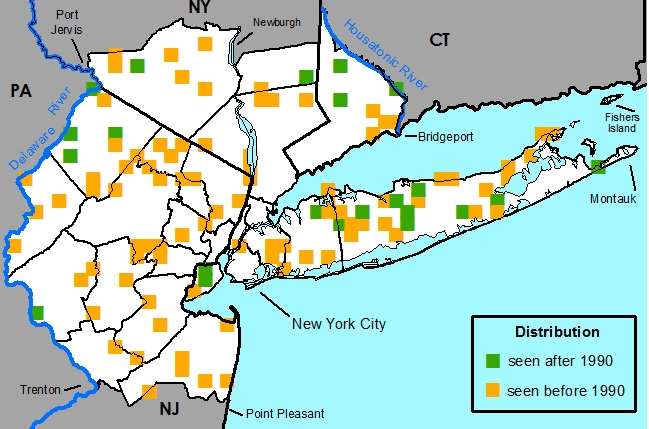Chimaphila umbellata (L. ) W. Barton Pipsessiwa - Pipsessiwa

Native , Occasional
By Steven Clemants
Not peer reviewed
Last Modified 02/01/2013

Common Names
PipsessiwaField Identification
An herb or subshrub with oblanceolate leaves and 2-3--flowered umbels of white flowers.Food uses
Disclaimer: The information provided here is for reference and historical use. We do not recommend nor do we condone the use of this species for food purposes without first consulting a physician.The leaves are made into a bitter tea by the Native Americans.
Medicinal uses
Disclaimer: The information provided here is for reference and historical use. We do not recommend nor do we condone the use of this species for medicinal purposes without first consulting a physician.(Hare et al., 1905) (Hussey, 1974) (Lewis & ElvinLewis, 1977) (Uphof, 1968)
The leaves, called "Folia Chimaphilae", are used for treating bladderstones and retarding excretion of urine as well as a tonic and diuretic. The Catawbas used it for backaches. Chimaphila umbellata contains ericolin, arbutin, chimaphilin, urson, tannin, and gallic acid and has been experimentally shown to have a hypoglycemic effect.
Common names
Pipsessiwa -- "to break up stones" referring to the use of this plant against bladderstones.
Poisonous properties
Disclaimer: The information provided here is for reference and historical use. If you believe you have been poisoned, please contact the Poison Control Office near you (look for the number in the front of the phone book).
The leaves and stems can cause dermatitis.
Nomenclature
*Pyrola umbellata L., Sp. Pl. 1: 396. 1753. *Chimaphila corymbosa Pursh, Fl. Am. Sept. 1: 300. 1814, nom. illeg. (Art. 53.1). *Chimaphila umbellata (L.) W. P. C. Barton, Veg. Mater. Med. U.S. 1: 17. 1817. *Pipseva officinalis Raf., Autik. Bot. 105. 1840, nom. illeg. (Art. 52.1). *Pserva umbellata (L.) Kuntze, Revis. Gen. Pl. 2: 390. 1891. TYPE: Location unknown, Anonymous s.n. (Lectotype: LINN #568.10), selected by (Dorr & Barrie, 1993).*Chimaphila umbellata var. cisatlantica S. F. Blake, Rhodora 19: 241. 1917. *Chimaphila umbellata ssp. cisatlantica (S. F. Blake) Hultén, Acta Univ. Lund, n.s. 44(1): 1203. 1948. TYPE: Canada. New Brunswick: Gloucester Co., Bathurst, 15 Aug 1913, S. F. Blake 5435 (Holotype: GH! #00019875).
Description
HABIT perennial, evergreen, phanerophyte or chamaephyte, shrubs, autotrophic, monoclinous, with fibrous roots and with adventitious roots, 0.1-0.2 m tall, with rhizomes.STEMS erect, round, not winged, "regular". Prickles absent. Bark ridged, not exfoliating, light yellowish orange or reddish violet. Branches erect, light yellowish orange, round, not winged. Pith present, white, round, continuous. Thorns absent. Aerial roots absent. Sap translucent. Resin absent.
LEAVES alternate or subopposite or opposite or whorled, 1-6 per node, crowded toward stem apex, divergent from stem, simple. Stipules absent. Leaves petiolate, petiole "typical", 0.3-1 cm long, glabrous, without glands. Leaf: abaxial surface dark green, adaxial surface light greenish yellow, blades narrowly elliptic or oblanceolate or elliptic or oblong, plane, symmetric, 2.6-6.1 cm long, 0.8-2 cm wide, coriaceous, base cuneate, margin serrate, apex acute, abaxial surface glabrous, without glands, adaxial surface glabrous, without glands. Eucamptodromous venation, veins 3-4. Leaf lobes absent. Spines absent. Tendrils absent.
INFLORESCENCES monomorphic, regular or, if dimorphic, female inflorescence simple, corymbose raceme, terminal. Peduncle present, 1-4.3 cm long. Rachis present, 0.4-0.7 cm long, bractless. Pedicel 0.7-1.8 mm long, hairs short and unbranched, hairs erect, multicellular, uniseriate, light yellowish orange or light orange-yellow, moderately dense, throughout, not glabrescent, glands present, glands at apex of hairs, yellowish orange. Bracteoles 1, sessile, at mid pedicel, not connate, bracteoles: abaxial surface dark violet-red, bracteole: adaxial surface dark violet-red, linear, plane, 3.3-4.5 mm long, 0.2-0.4 mm wide, base truncate, margin glandular ciliate, apex acuminate. Cupules absent.
FLOWERS serotinous, formed on long shoots, monomorphic, with sepals and petals readily distinguishable from one another, bisexual, flowers white, 5-merous, 6-9 mm long, 9-11 mm wide, (1-)3-5 flowers per inflorescence, fragrance present, perianth of one whorl. Calyx present, actinomorphic, acetabuliform (?), of free sepals, persistent, abaxial and adaxial surfaces the same color, light yellowish green, none, 2.3-3.2 mm long, 4.5-5 mm wide. Sepals or sepal lobes 5, very widely ovate, 1.1-1.8(-2.4) mm long, 1.1-2.2 mm wide, base truncate, margin ciliate, apex obtuse, abaxial surface glabrous, without glands, adaxial surface glabrous, without glands. Epicalyx absent. Corolla present, actinomorphic, acetabuliform (?), of free petals, deciduous, abaxial and adaxial surfaces the same color, light red, none, 3-6.5 mm long, 10-11 mm wide. Petals or petal lobes 5, "normal", elliptic or obovate, 4.5-5 mm long, 3.5-4.5 mm wide, base acute, margin ciliate, apex acute, abaxial surface glabrous, without glands, adaxial surface glabrous, without glands. Gynoecium syncarpous. Carpels 5. Stigmas 1, broadly capitate. Styles absent, the stigma sessile on the ovary. Ovary superior, 2 mm long, 5 mm wide, nectiferous disk present. Locules 5. Placentation axile. Androecium obdiplostemonous. Stamens 10, 4.5 mm long. Anthers ellipsoid, opening by pores, opening 1/4 of entire anther, bithecal, reddish violet or dark violet-red, papillose, erect, unicellular, uniseriate. Filaments free, straight, dark violet-red, hairs short and unbranched, erect, unicellular, uniseriate. Staminodes absent.
FRUITS loculicidal capsule, dark reddish orange or dark orange or dark yellowish orange, depressed globose, 2.6-6 mm long, 3.7-11 mm wide, glabrous, without glands.
SEEDS many, translucent, fusiform, 0.4-0.9 mm long, 0.1-0.2 mm wide, wingless, tailed, ribbed.
Habitat
(Meehan, 1899) (Wherry, 1920) (Wherry, 1920)
Woods dominated by pine, oak, or hickory. Growing in dry or moist soils with a pH of 5-6.
Rarity Status
Heritage global rank -- G5Connecticut -- not listed
New Jersey -- not listed
New York -- not listed
Species Biology
FloweringJune [week 4] - July [week 4].
Pollination
(Standley et al., 1988)Melittophily -- Principally pollinated by bumble bees (Bombus), primarily B. bimaculatus Cr. and B. vagans Sm. Not buzz-pollinated.
Fruiting
(June [week 3]) July [week 2] - Oct [week 3] (Dec [week 3]).
Dispersal
Anemochory -- Probably wind.
Germination
Unknown.